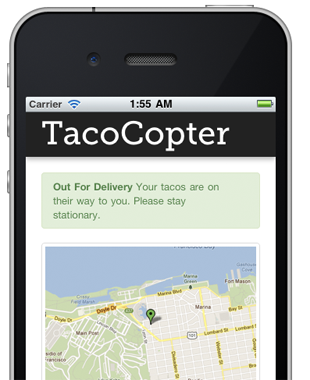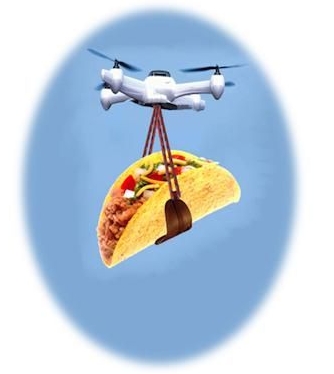Posted April 1. “Flying Robots Deliver Tacos To Your Location – Our unmanned delivery agents are fast and work tirelessly.”
Here’s how it works: You order through an app on your smartphone, and after the taco has been prepared at TacoCopter’s headquarters, instead of being delivered by a person riding a scooter or driving a car, it’ll come by an unmanned drone-style quad-copter.
That’s right, at its core, TacoCopter employs robot slaves to deliver delicious Mexican food whenever the mood takes us. The future is now. According to the website, TacoCopter is in “private beta” and available in the San Francisco Bay area only.
The Tacocopter site, which has been up since last July but only in the past few days has garnered media attention, has been liked on Facebook more than 14,000 times, and retweeted close to 4,000 times.
Tacocopter isn’t a real app or startup. The technical, safety and legal hurdles facing such a taco-delivery system are near insurmountable in today’s environment . No, Tacocopter is nothing more than a product concept created by Star Simpson, an MIT grad who stumbled into the limelight in 2007 after she was arrested for wearing a hoax explosive device comprised of a circuit board and green LEDs.
 Simpson, who’s currently in Shenzen, China working on an actual project called Canidu, took some time to answer a few questions about Tacocopter. “I wouldn’t say it was ever considered a joke,” Simpson said of the site. “Quadcopters are fascinating, and I’m taken with the idea that the possibilities for using them in non-flying death robot contexts.”
Simpson, who’s currently in Shenzen, China working on an actual project called Canidu, took some time to answer a few questions about Tacocopter. “I wouldn’t say it was ever considered a joke,” Simpson said of the site. “Quadcopters are fascinating, and I’m taken with the idea that the possibilities for using them in non-flying death robot contexts.”
Simpson and compadres Dustin Boyer and Scott Torborg created the Tacocopter site for a few reasons. “Partly it was so I would keep thinking about how to make something like this work, and partly it was to do the same for other people. A vision. Like what cyberpunk did for the Internet — mull the possibilities, give people things to think about,” Simpson said in an interview over AIM. “The other motivation is that we basically only hear about quadrotors in scary contexts, and I think it does give that fear and emotional tension a safe and hilarious outlet.”
Simpson cautiously thinks something like Tacocopter could become a reality in the future, but for now, the system described by the Tacocopter website is difficult to accomplish in reality: Under FAA guidelines, commercial use of unmanned aerial vehicles, or UAVs, is only possible with an incredibly difficult-to-obtain license.
If the FAA did relax its regulations, Simpson thinks “a network of command and recharging centers attached to kitchens capable of fulfilling demand orders could easily satisfy the taco delivery needs of a metropolitan area like San Francisco.”
As for whether a drone or a remote control flying vehicle would be used, Simpson said, “I think the best option for an urban context would be a remote operated vehicle — something flown by a pilot who could respond to difficult-to-map obstacles like the street lamps and balconies you’d inevitably have to deal with.”
Simpson was careful to note that many questions surrounding Tacocopter remain. Among other matters, her brain trust would need to consider optimal routing, human safety, dealing with wind and weather, vehicle control, taco delivery handoff and taco impact, and pricing.
If Tacocopter ever does become a reality, those who entered email addresses into the Tacocopter website will be notified.
Flying Taco Photo Credit: Digital Trends
Source: Wired: Gadget Lab


